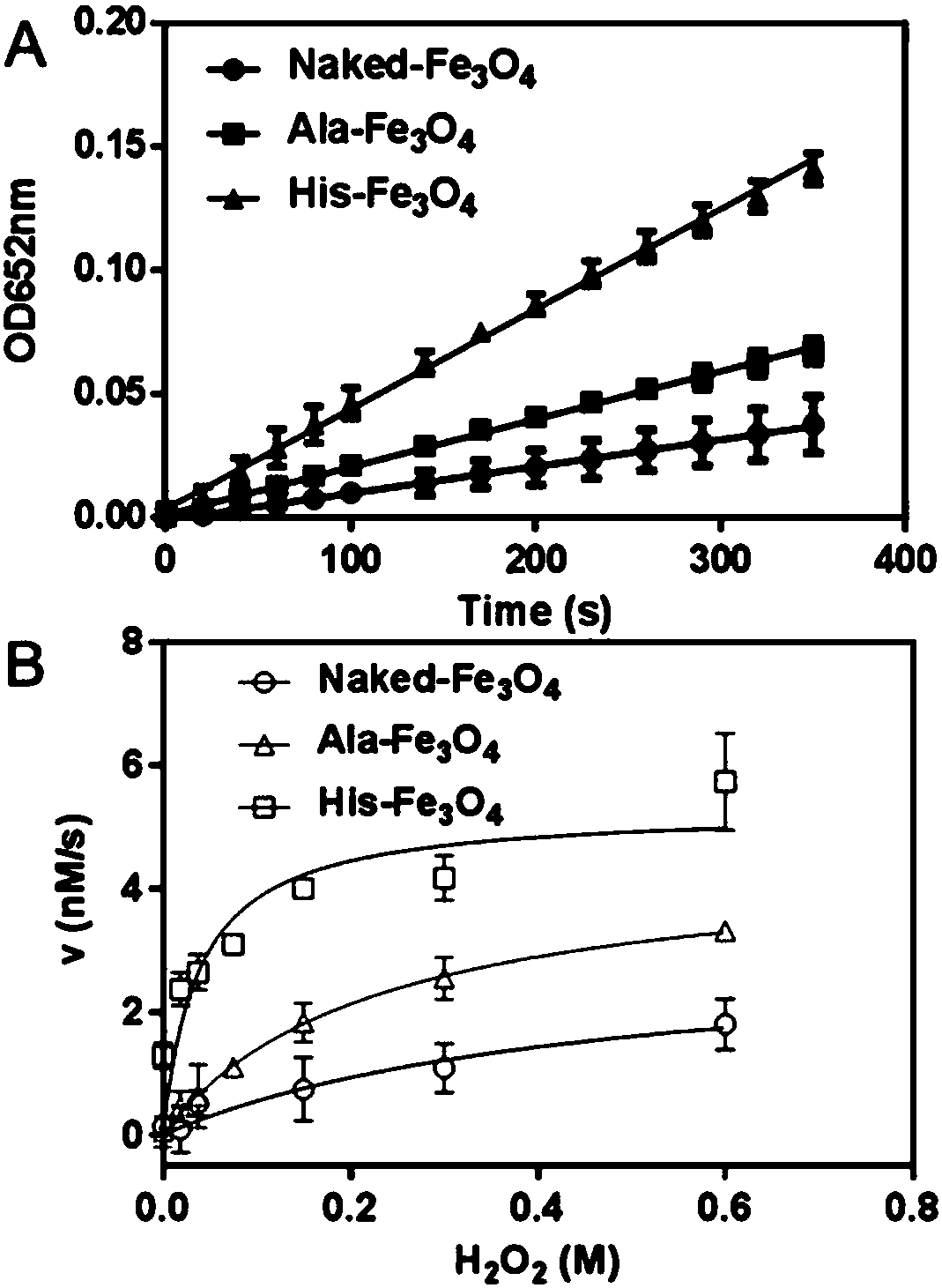Method for optimizing activity of nano-enzyme particles
A nanoparticle and nanozyme technology, applied in the field of nanobiology and nanomedicine research, nanomaterials, can solve problems such as not universal
- Summary
- Abstract
- Description
- Claims
- Application Information
AI Technical Summary
Problems solved by technology
Method used
Image
Examples
Embodiment 1
[0037] Embodiment 1: Amino acid modification Fe 3 o 4 Preparation and Characterization of Nanozyme Particles
[0038] In this example, amino acid modified Fc 3 o 4 Nanozyme particles were synthesized using a hydrothermal method. Specifically as follows: 3g FeCl 3 Add 80mL of ethylene glycol and mix well, after fully dissolved, add 6g of anhydrous sodium acetate, 0.1g of alanine or histidine, mix thoroughly for 30 minutes, then put the sample into the reaction kettle, and react at 200°C for 14 hours . After cooling, magnetically separate, wash with ethanol, dry at 60°C, and store in separate packages. Fe synthesized by this method 3 o 4 The surface of nanozyme particles is modified with alanine or histidine, which are respectively denoted as Ala-Fe 3 o 4 , His-Fe 3 o 4 . where unmodified Fe 3 o 4 The nanozyme particles are named as Naked-Fe 3 o 4 .
[0039] amino acid modified Fe 3 o 4 Nanozyme particles and unmodified Fe 3 o 4Nanozyme Particles Nanopartic...
Embodiment 2
[0041] Example 2 Histidine modification on Fc 3 o 4 Effect of Nanozyme Particle Activity
[0042] 0.2 μg Fe with different amino acid modifications 3 o 4 Nanozyme particles and bare Fe 3 o 4 Nanozyme particles were added to 100 μL of reaction solution (0.2M sodium acetate, pH 4.5). Then add H at a final concentration of 0.1M 2 o 2 And 0.8mM 3,3,5,5-tetramethylbenzidine (TMB), microplate reader iMark TM Microplate Reader (Bio-Rad, USA) measured absorbance at 652 nm.
[0043] The result is as figure 2 As shown in A, histidine modification can significantly increase Fe 3 o 4 Peroxidase activity of nanozyme particles.
Embodiment 3
[0044] Example 3 Histidine modification on Fe 3 o 4 Nanozyme particle to substrate H 2 o 2 The affinity and reaction kinetics of the
[0045] Fe 3 o 4 Nanozyme particles and HRP on the substrate H 2 o 2 The reaction kinetics is carried out according to the following scheme:
[0046] Differently modified Fe 3 o 4 Add 0.2 μg or 0.1ng HRP of nanozyme particles to 100 μL reaction solution (0.2M sodium acetate, pH 4.5). Add 0.8mM TMB and gradient changes of H 2 o 2 , and then use iMark TM Microplate Reader (Bio-Rad, USA) detects the whole reaction system, draws the reaction curve, according to the Mie reaction equation ν=V max ×[S] / (K M +[S]) to calculate the Mie reaction constant. where V max is the maximum reaction rate; [S] is the molar concentration of enzyme added; K M is the Michaelis reaction constant; K cat Worth calculated according to equation K cat =V max / [S] Calculated.
[0047] The Mie reaction equation curve drawn is as follows figure 2 As sho...
PUM
 Login to View More
Login to View More Abstract
Description
Claims
Application Information
 Login to View More
Login to View More - R&D
- Intellectual Property
- Life Sciences
- Materials
- Tech Scout
- Unparalleled Data Quality
- Higher Quality Content
- 60% Fewer Hallucinations
Browse by: Latest US Patents, China's latest patents, Technical Efficacy Thesaurus, Application Domain, Technology Topic, Popular Technical Reports.
© 2025 PatSnap. All rights reserved.Legal|Privacy policy|Modern Slavery Act Transparency Statement|Sitemap|About US| Contact US: help@patsnap.com



